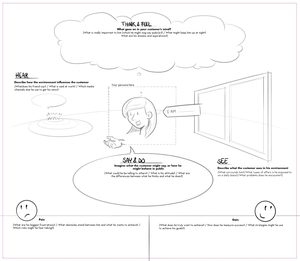Empathy Map

The empathy map allows you to generate a deeper understanding of one’s motivations and why.
Goal
With this tool, we gather insights about the potential target group. It helps us to rank information and to detect contradictions. The various questions give insights into people’s underlying needs and help explain behavior.
You can use the map during conversations with people, as a means to get a complete overview of this person. You can also use this map beforehand, to draw a persona, with several assumptions, that you can validate and test later in the process. You write down their name, a description of them in keywords, their thoughts and feelings, behavior, and attitude towards others, and how this person perceives his or her environment.
Materials
Instructions
Begin with the name and place the user’s picture in the middle of it. Describe him/her in keywords. Next, fill in what the user is thinking and feeling. What are the triggers, what really counts to her/him, what are her/his major occupations, worries and aspirations? How does the persona act and what does she/he say? Name specific actions, describe his/her attitude in public appearances, behavior towards others, or a typical quote. Next, think about what your persona sees and experiences in his/her environment, with friends, events, media, and advertising. What does he/she hear from friends, family, co-workers and boss, and influencers? What are his or her gains? These can be both functional needs and measures of success. Lastly, fill in the persona’s pains: their frustrations, obstacles, and fears.
1. Name: the person’s name and description in keywords.
2. Think & Feel: what this person finds important; their triggers, worries, and aspirations.
3. Act & Say: the person's actions, public appearance, attitude, and behavior towards others.
4. See & Experience: how the person perceives his/her environment.
5. Hear: what friends/family/co-workers/influencers say about this person.
6. Gains: emotional and functional needs, measures of success.
7. Pains: frustrations, obstacles, fears.
Attachments
- 10b_FORMAT_Empathy-map-(met-paingain)31-8.jpeg